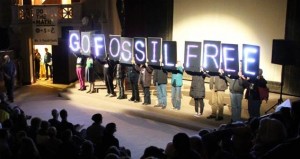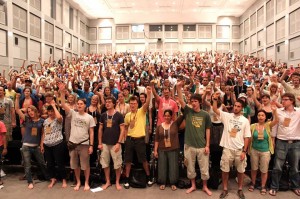Connecting the Dots: Disinvestment & Global Agreement
 Every year young people attend the UN climate talks to push for more ambition. Every session we hear the same line – if you really want to make a difference, go and take action at home. Every time I hear these words, I want to scream. Climate change is the biggest threat to our future; of course young people are taking action at home. Disinvestment is not the first, nor is it likely to be the last, action that young people take on climate change in their communities. But perhaps this time its locally organised, globally networked nature will provide us with a message that can echo loudly through the corridors of the UNFCCC. A message to negotiators, ministers and stakeholders alike, that the shift to a low carbon world is happening. Holding globalised economic actors to account can be challenging, but disinvesting locally opens a channel between local and globalised power, forming a place for intervention and resistance. I am hopeful, that the disinvestment movement will not only provide a platform for greater action in numbers and impact, but also an opportunity to demand greater listening. Listen up, people are taking action in our community and communities like us all across the world.
Every year young people attend the UN climate talks to push for more ambition. Every session we hear the same line – if you really want to make a difference, go and take action at home. Every time I hear these words, I want to scream. Climate change is the biggest threat to our future; of course young people are taking action at home. Disinvestment is not the first, nor is it likely to be the last, action that young people take on climate change in their communities. But perhaps this time its locally organised, globally networked nature will provide us with a message that can echo loudly through the corridors of the UNFCCC. A message to negotiators, ministers and stakeholders alike, that the shift to a low carbon world is happening. Holding globalised economic actors to account can be challenging, but disinvesting locally opens a channel between local and globalised power, forming a place for intervention and resistance. I am hopeful, that the disinvestment movement will not only provide a platform for greater action in numbers and impact, but also an opportunity to demand greater listening. Listen up, people are taking action in our community and communities like us all across the world.
What is disinvestment?
Simply put disinvestment involves an economic boycott designed to pressure institutions into making positive change. Disinvestment has been a successful tactic in a number of campaigns, most famously in the battle to end apartheid in South Africa.
For the environmental movement disinvestment is an old tactic in a new context. It involves disinvesting institutional and personal investments from high carbon assets.
For more information on disinvestment campaigns in your region check out - http://gofossilfree.org/regions/
Movements vs. Elite advocacy
That was a bit of a misleading title - this is not an either or scenario. We must embrace a pluralist approach for all actors to shift to a low carbon world. Since Copenhagen there has been widespread disillusionment in the ability and willingness of institutions like the UN to take action on climate change. We mobilised and protested and whilst some argue the benefits of incremental change, there has been no much needed transformational outcome. Disinvestment gives us the opportunity to act apart from these large institutions whilst striving to liberate these elite structures from the stranglehold of corporate power.
By working within the institutions we are already part of, away from the protected untouchable elite, we can renew a sense of agency and demonstrate a stronger democratic mandate for change. The physical practice of disinvesting assets is not the only outcome, perhaps it isn’t even the most impactful outcome. For me the real power comes in the process. By taking action in your community, be that your university, school, workplace or home, a moral debate amongst peers is inevitable. We confront and reclaim responsibility, remembering the influence that is often forgotten in the journey between our actions and those of corporations or governments. Where you invest your money in relation to its impact on the climate becomes an active choice. The choice is about willingness not capability; we are all capable of disinvesting our futures from a high carbon world.
Tackling climate change can seem overwhelming and inaccessible. Whilst changing to a more energy efficient light bulb can be an important first step toward making more informed sustainable choices, it does not address the systemic issues that underpin climate change and undermine multilateral cooperation. Disinvestment provides us with a tool where collectively we begin to dig into these underlying problems, delegitimising the high carbon, unaccountable corporate power that frequently inhibits progress and cooperation.
Elite advocacy is subject to many of the same constraints as elite institutions, without social movements like disinvestment all will struggle to bring about the change we need. For the UNFCCC to succeed it must uphold its responsibility as a space for reciprocity, fairness and collaboration. A democratic forum for global agreement where knowledgeable advocates have a positive influence and extend the spectrum of possibility. It cannot be held hostage by the few actors who want to maintain and extend their power to prolong the devastating high carbon regime.
But what do the UN climate talks mean to the divestment movement?
 Part of me wants to reply, it should mean nothing. Why should the thousands of people in social movements working for a better world be subsumed by the UN complete with its own problems? However, as things stand a relationship is inevitable, and not only that - it has the potential to make us stronger.
Part of me wants to reply, it should mean nothing. Why should the thousands of people in social movements working for a better world be subsumed by the UN complete with its own problems? However, as things stand a relationship is inevitable, and not only that - it has the potential to make us stronger.
The UN does have its advantages. A big signal, a grand gesture, from the UN will accelerate climate action. An agreement brings a degree of stability: even when governments change they are held accountable to uphold international agreements. In turn, investors and global corporations take note and adjust to fit emerging long term trends. The UN is a big player in the confidence game - a confirmation for investors that governments have reached a consensus that will not change. But transformation is a scary word and when we need confidence in bucket loads, the UN alone is not enough. Whilst our protest did not achieve the necessary action from the UN in the past, innovative approaches like the disinvestment movement will benefit from a complimentary, pluralist approach.
A Global agreement for solving climate change
The UN is one of many venues to have global agreement for solving climate change. Frontline communities across the world stand in solidarity with one another, in other words in ‘global agreement’, for solving climate change. From communities exposed to destructive fracking, to young people fighting for their futures, these communities cross our planet, dissolving artificial boundaries to enact transformational alternatives at scale.
Unlike the UN where entry is limited, disinvestment can reach into communities around the world. Creating conversations between friends, colleagues and family which draw us into the debate and enabling us to act differently. A global deal solely from the UN is a fallacy; we need a global deal between people to make the shift. Each and every one of us has a part to play in the low carbon world and we all need our opportunity to claim it. A UN Agreement is a key and tactical intervention along the way, as is disinvestment.
Advice for COP19
I’ve thought about this a lot. If you’ve got this far through my blog, you probably believe it! Here are a few suggestions for how we could message disinvestment at Warsaw. This list is not exhaustive and I would encourage you all to contribute, but here are a few ideas to get us started:
- Global agreement is possible. Agreement can exist inside and outside of the UNFCCC. Young people are demonstrating their agreement through disinvesting their futures from a high carbon world. Negotiators and parties must step up, follow suit and reach a global Agreement under the UNFCCC.
- Locally organised, globally networked. I don’t speak as one young person from the UK; I speak as one of the 3.5 billion young people across the world. We are organised and we are having influence globally. It is not only governments and corporations that can make global interventions. There is an ever-growing democratic mandate for global progress toward a low carbon world.
- Explore what disinvestment means across the global North-South divide. The disinvestment movement started in the US and has spread but largely remains in the global North. Although, as I said before, I hope this movement helps to dissolve the artificial boundaries of global North and South, there is the weight of history that must be acknowledged. Conversations within the youth movement will help explore the complexities of difference and foster greater global representation.
My final piece of advice is please don’t just listen to me. Climate change is accelerating at an unprecedented pace and we need a whole range of different voices, translating and bridging across cultural divides. The fight is on for a transformational global shift and disinvestment is one part of this puzzle that you can be part of. I call on you all to reclaim responsibility locally on the pathway to global, democratic and collective transformation.




-
Sébastien
-
http://ukycc.org/divestment-global-youth-putting-the-big-picture-together/ Divestment: Global youth putting the big picture together | UK Youth Climate Coalition
-
http://ukycc.org/bringing-divestment-to-an-international-audience/ Bringing Divestment to an International Audience | UK Youth Climate Coalition
About the author
Camilla Born
Activist enacting the transformation toward a democratic low carbon world. Co-director of the UK Youth Climate Coalition and researcher at E3G.





